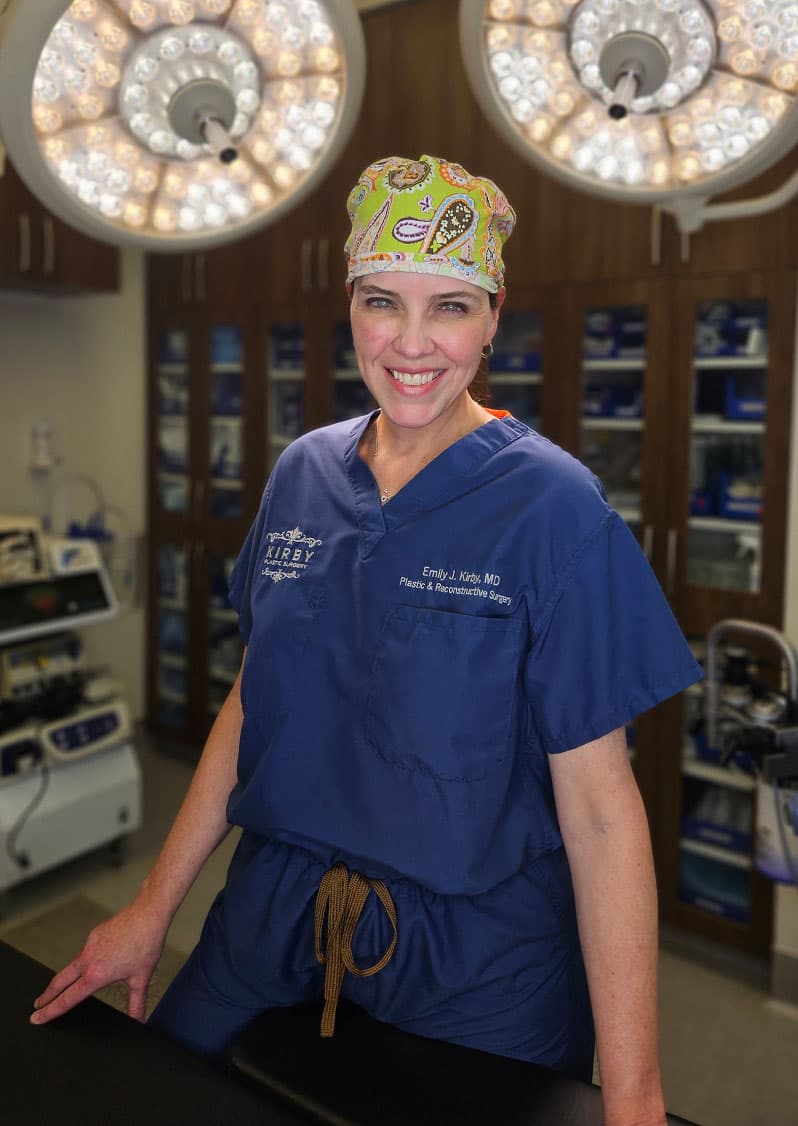Breast Reduction Fort Worth

Breast reduction is ideal for women who suffer discomfort or embarrassment from the size/weight of large breasts. A breast reduction removes excess skin, breast tissue, and fat to reveal a breast shape and size that is more appropriate for your frame. Board Certified Plastic Surgeon Dr. Emily J. Kirby performs breast reduction surgery in Fort Worth, TX.
What to expect during your breast reduction consultation
Your consultation takes about one hour. You’ll spend most of that time with Dr. Kirby discussing your goals, concerns, and questions, and learning how Dr. Kirby tailors the procedure to address each of these. You’ll also get to meet our nursing staff who will take your vitals and review your medical history, and our patient care coordinator will schedule your procedure and help guide you through the process from start to finish.
“Dr. Kirby and her staff are extremely approachable and easy to talk to. They were supportive throughout the process and answered all of my numerous questions. I’m extremely happy with my breast reduction results – absolutely life changing. I was referred to her by another satisfied patient and I’m so glad I chose Dr. Kirby.”
Where will my breast reduction incisions be?
During breast reduction surgery, incisions are made in order to remove extra breast tissue, fat, and skin. Liposuction may be used during your breast reduction as well. The appropriate technique will be chosen by you and Dr. Kirby together and will be based on your breast size, shape, and position. Incisions can be made in a few different patterns, but the most common are the “lollipop” and the “anchor” (or “inverted T”) incisions. Your areola will likely be made smaller during the breast reduction procedure to match the shape and size of your new breasts. Since skin and soft tissue is being removed, there is not a good way to camouflage scars on your breast. However, most scars heal very well and do not show under clothing, swimsuits, or bras.
Female Plastic Surgeon Fort Worth
- Board-Certified Plastic Surgeon
- Over 14 years of experience in private practice
- Founder and Medical Director of Kirby Plastic Surgery, Kalos Medical Spa, and City Surgery Center—a Quad A-accredited, state-of-the-art facility located onsite
- Specialist in breast surgery and body contouring, including postpartum
- Castle Connolly Top Doctor since 2019
- First female Chief of Plastic Surgery, Texas Health Resources Harris Methodist Hospital
What happens during a breast reduction procedure
A breast reduction removes excess skin, breast tissue, and fat to reveal a breast shape and size that is more appropriate for your frame. In this video, Dr. Kirby explains what exactly happens during a breast reduction procedure to create lighter, smaller, more lifted breasts.
What kind of anesthesia will I have?
Breast reduction surgery is performed under general anesthesia for optimal comfort. You will be asleep for the entire surgery.
How long does breast reduction surgery take to perform?
Breast reduction surgery, if performed alone, typically takes 2 to 3 hours. Combination surgery (for example, with liposuction) will take longer.
- Key Benefits
- Glossary
- Alleviates or minimizes chronic pain in the back, neck, and shoulders caused by the weight and droop of the breasts
- Improves posture by reducing the forward pull on the spine and kyphosis (outward curvature of the upper spine often seen with large breasts)
- Makes physical activities and exercise more comfortable, encouraging a more active and healthier lifestyle
- Reduces skin irritation and rashes that often occur beneath or between large breasts
- Anchor Incision: A common surgical technique for breast reduction that involves an incision around the areola, vertically down to the breast crease, and horizontally along the breast crease, resembling an anchor shape, suitable for most reductions.
- Breast Reduction: A surgical procedure to remove excess breast fat, glandular tissue, and skin to achieve a breast size in proportion with the body and to alleviate discomfort associated with overly large breasts.
- Gigantomastia: A medical condition characterized by excessive breast growth that can cause physical discomfort and psychological distress, often treated with breast reduction surgery.
- Glandular Tissue: The breast tissue that produces milk; in breast reduction surgery, excess glandular tissue is removed along with fat to decrease breast size.
- Inferior Pedicle Technique: A technique used in breast reduction where a portion of lower breast tissue is preserved to maintain blood supply to the nipple and areola, helping to maintain sensation, blood supply, and milk ducts.
- Liposuction: In the context of breast reduction, a technique that may be used to remove excess fatty tissue from the breasts, especially in cases where less glandular tissue needs to be removed. Liposuction may also be used along the sides of the chest to narrow the silhouette further.
- Macromastia: The medical term for larger breast size, which is often treated with breast reduction surgery.
- Mammoplasty/Mammaplasty: The medical term for any cosmetic or reconstructive surgical procedure on the breasts, including breast reduction, “reduction mammaplasty.”
- Nipple-Areola Complex Reduction: A procedure that is typically performed as part of breast reduction to reduce the size of the areola and to reposition the nipple to a more natural-looking location on the new smaller breast.
- Recovery Time: The period after surgery during which the patient heals; for breast reduction, this includes time for swelling and bruising to subside, and for the patient to gradually return to normal activities, typically ranging from a few days to several weeks. Recovery can be streamlined, but not rushed.
- Scar Management: Techniques and treatments used to minimize the appearance of scars following breast reduction surgery, including scar massage, silicone treatments, gels, and laser, tox, or microneedling treatments.
- Superior or Superomedial Pedicle Technique: A breast reduction method in which the nipple-areola complex is left attached to a pedicle of tissue from the superior part of the breast in order to maintain blood supply to the nipple and areola. This helps to preserve sensation, blood supply, and milk ducts.
- Vertical Scar Technique (Lollipop Incision): A breast reduction technique that involves an incision around the areola and vertically down to the breast crease, suitable for small reductions.
- Weight Restrictions: Post-surgery guidelines that include limitations on lifting heavy objects and avoiding certain activities to ensure proper healing and to maintain the results of the breast reduction.
What are the risks?
Your decision to undergo breast reduction surgery is a personal decision and should be made with a full understanding of the benefits and potential complications of the procedure. Most breast reduction incisions are made in areas that are visible on the bare breast, resulting in scars that are not visible under clothing. Other risks include bleeding, infection, contour irregularities, skin discoloration, asymmetry, and permanently altered sensation in the nipple and/or other areas of the breast. Some patients will experience healing problems of the nipple and/or breast following surgery. Although good results are expected, there is no guarantee. In some situations, it may not be possible to achieve optimal results with a single surgical procedure and another surgery may be necessary.
Real patient images from Board-Certified Plastic Surgeon Dr. Emily Kirby
*Individual results may vary.
How do I prepare for breast reduction surgery?
Prior to any procedure, it is necessary to review medications you are taking that may affect your surgery. You may be asked to stop or to adjust some medications you are on. As always, it is important to include supplements on your list of medications. Aspirin and aspirin products (Alka-Seltzer®, Carisoprodol, Excedrin®, Goody’s®, Midol®), anti-inflammatory medications (except acetaminophen, or Tylenol®), and herbal supplements must be avoided for 10 days prior to your surgery. Learn more about which medications and supplements to avoid. Dr. Kirby will discuss your medications with you.
Depending on your medical condition, you may be asked to get lab testing or a medical checkup prior to your surgery. You may also be asked to have an updated mammogram prior to your surgery if you have not had one recently.
Tobacco products impair your body’s ability to heal. You will be asked to stop smoking for 6 weeks prior to any surgery. Tobacco step-down products such as chewing gum and Nicoderm® continue to provide your body with tobacco and must be stopped as well. Please ask Dr. Kirby if you will need assistance with quitting.
Be sure to arrange for a responsible adult to drive you to and from your surgery. You will need someone to stay with you the night following your surgery as well.
You will receive specific instructions for your surgery day from Dr. Kirby’s office.
“Thank you to Dr. Kirby and team for the amazing work and service I received. Your work is truly a piece of art! I will be sharing your name with all of my friends.”
What to expect after breast reduction surgery
Following your breast reduction surgery, you will notice that your breasts have been reduced, lifted, and shaped. Sutures are placed underneath the skin as well as on the skin. Dressings will cover your incisions immediately after surgery. You will also notice that you have quite a bit of swelling that will decrease over the next few weeks. You should expect to have some soreness and possibly some temporary changes in sensation as well. You will be asked to wear a supportive or surgical bra following surgery as your breasts heal from the procedure. Dr. Kirby will discuss with you when your dressings will be removed and when to return for a post-operative visit.
Recovery time for breast reduction
Depending on your job, you can expect to return to work within 7 days. More strenuous activity, however, especially using your arms, cannot be resumed until 4 to 6 weeks after surgery. You will be directed on scar massage techniques by Dr. Kirby when the timing is appropriate.
What can I expect plastic surgery recovery to be like?
Dr. Kirby’s goal is to get you back on your feet after your surgery as soon as possible! In this video, she explains what you can expect recovery to be like after your plastic surgery procedure.
Dr. Emily Kirby ensures that every plastic surgery patient receives Enhanced Recovery After Surgery (ERAS) care to optimize recovery time and minimize pain. Dr. Kirby uses innovative pain reduction techniques, such as numbing anesthetics and small doses of different types of medications, to reduce discomfort from many angles.
“Dr. Kirby has created the most amazing experience. She is thorough and intuitive, sincerely cares about the work she does and perfectly marries listening to what you want and what science says.”
—Actual patient
References »
Chiummariello S, Angelisanti M, Arleo S, Alfano C. Evaluation of the sensitivity after reduction mammoplasty. Our experience and review of the literature. Annali Italiani di Chirurgia. 2013 Jul-Aug;84(4):385-8.
Xia TY, Scomacao I, Duraes E, Cakmakoglu C, Schwarz G. Aesthetic, Quality-of-Life, and Clinical Outcomes after Inferior Pedicle Oncoplastic Reduction Mammoplasty. Aesthetic Plastic Surgery. 2023 Jun;47(3):905-911. doi: 10.1007/s00266-023-03257-7.
Jørgensen MG, Albertsdottir E, Dalaei F, Hesselfeldt-Nielsen J, Schmidt VJ, Sørensen JA, Toyserkani NM. Superomedial Reduction Mammoplasty Affects Patients’ Ability to Breastfeed in a Distinct Manner: A Multicenter Study of 303 Patients. Aesthetic Surgery Journal. 2021 Oct 15;41(11):NP1498-NP1507. doi: 10.1093/asj/sjab263.
Brown DM, Young VL. Reduction mammoplasty for macromastia. Aesthetic Plastic Surgery. 1993 Summer;17(3):211-23. doi: 10.1007/BF00636264.
Area Served:
Call today to book your consultation with Dr. Emily J. Kirby- Discuss your goals and concerns
- Obtain a unique female perspective
- Review convenient financing options
- call or TEXT (817) 292-4200 or contact us today!

Medically reviewed by Dr. Emily J. Kirby — Updated on Mar 21, 2025
